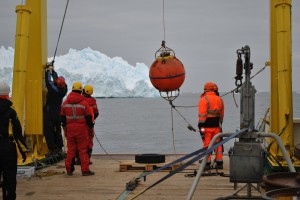Local weather plays an important part in the retreat of the ice shelves in West Antarctica, according to new research published in the journal Nature Communications.
The study led by scientists at the University of East Anglia (UEA) of the Pine Island Glacier (PIG) used a unique five-year record to study how the interactions between the ocean and the atmosphere, as well as changing currents, control how heat is transported to, and beneath, the Pine Island Ice Shelf.

Mooring buoy being collected off the Korean research vessel RV Araon. Photo: Anna Wåhlin, University of Gothenburg.
Pine Island Glacier is one of the fastest melting glaciers in Antarctica with some studies suggesting that its eventual collapse is almost inevitable.
Previous research suggested more warm water was circulating under the ice shelf and melting it more rapidly, leading to an increasing contribution to sea level rise. However relatively little was known about what drives changes in ocean conditions in this remote part of Antarctica due to its inaccessibility. Some studies suggested that the ocean conditions close to Pine Island Glacier are influenced most strongly by winds at the edge of the continental shelf, some 400 km to the north, which in turn respond to changes in tropical ocean temperatures.
The study looked at the impact of shelf-edge winds and found this to be less direct than previously thought, and that local atmospheric conditions and ocean circulation are the main drivers of ocean temperature changes in the critical 350-700m depth range, over the period of observation.
Dr Ben Webber, oceanographer at UEA’s School of Environmental Sciences said: “The ice shelves of the Amundsen Sea – an area of the Southern Ocean – protect much of the West Antarctic Ice Sheet from collapse. These ice shelves are rapidly losing mass and understanding the mechanisms which control ocean conditions and drive melting of these glaciers is hugely important.
“We found a strong annual cycle in the exchange of heat between the ocean and the atmosphere, which drives changes in ocean temperature. While these changes are less evident in deeper waters, through convection and mixing the heat can penetrate deeply enough to have a major impact on melting and influence the temperature of the water entering the cavity under the glacier.
“There was a colder weather period from 2012-13, however, a separate study has shown that this only led to a partial slowdown of the glacier’s retreat, and many glaciers in the region have been retreating for decades and aren’t slowing down.”
Changes in the direction of the ocean currents also cause changes in temperature close to Pine Island Glacier. The colder period was associated with a reversal in the currents that transport heat into and around the bay.
Co-author Dr Povl Abrahamsen, oceanographer at British Antarctic Survey, said: “Most of the ocean data around Antarctica are snapshots of conditions – and many areas are only visited once every one or two years, if that. A continuous five-year time series near Pine Island Glacier, one of the fastest-melting glaciers in Antarctica, lets us see what is happening between these snapshots, giving us insights into the processes driving the melting of Pine Island Glacier.”
Dr Webber continued: “It is likely that other ice shelves around Antarctica that are melting due to warm ocean conditions will also be strongly influenced by local atmospheric conditions. This would underline the importance of atmospheric and ocean monitoring close to the Antarctic coasts to give early warning of future changes in ice shelf melting and glacial retreat.”
The research was carried as part of the Natural Environment Research Council (NERC)-funded iSTAR Programme and was in collaboration with US and Korean collaborators using data from ship-based and atmospheric observations including ship-deployed oceanographic moorings.
‘Mechanisms driving variability in the ocean forcing of Pine Island Glacier’ is published in the journal Nature Communications.
ENDS
Notes to editors
1/ For more information or to arrange interviews or photographs, please contact Lucy Clegg in the UEA Press Office on 01603 592764 or lucy.clegg@uea.ac.uk
2/ The full paper is available to download here: http://www.nature.com/articles/ncomms14507
3/ Images are available to download here: (link)
4/ University of East Anglia
The University of East Anglia (UEA) is a UK Top 15 university and ranks in the top one per cent of universities in the world. Known for its world-leading research and outstanding student experience, it has achieved a Top 10 rating in the National Student Survey every year since the survey began. UEA is a leading member of the Norwich Research Park – one of Europe’s biggest concentrations of researchers in the fields of environment, health and plant science. www.uea.ac.uk.
5/ This research was funded by the NERC iSTAR Programme, which aims to improve understanding of what’s happening to the area of the West Antarctic Ice Sheet where the greatest rates of ice loss over the last decades have been observed. New knowledge about the stability of this ice sheet is critical for making better predictions about how the ocean and ice will respond to environmental change, and what impact this may have on future sea level.
iSTAR is an ambitious scientific programme funded by the Natural Environment Research Council (NERC). It brings together leading scientists from 11 UK universities and from British Antarctic Survey (BAS).
